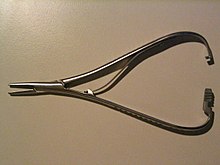Needle holder
As needle holders are surgical instruments referred to in suturing hold the needle firmly. There are different types.
Structure and functionality
In the operative specialties, sutures are almost exclusively created using a needle holder. The reasons for this lie firstly in the need for precise control of the needles, secondly in the need to be able to create sutures even in deep, difficult-to-reach operating areas and thirdly in the best possible avoidance of the risk of injury for the surgeon. Needlestick injuries with spit through the surgical glove can lead to infections with hepatitis viruses, HIV and bacterial diseases in the surgeon, and vice versa, damaged gloves and wounds on the surgeon's hand can cause wound infections in the patient. Fine, atraumatic needles can only be grasped and guided with such an instrument . The needle holder makes it easier for surgeons to make knots. The needle holders are made in different sizes depending on the area of application, for example microsurgery , microdentistry or periodontal surgery .
A needle holder always has special jaws in which the needle is clamped to prevent it from slipping. For this purpose, the jaws or their hardened lining have special surface structures, for example, are herringbone or waffle-like corrugated or provided with a groove that is adapted to the diameter of the needle.
A needle holder is usually provided with a lock (the so-called lock ) that prevents it from being opened unintentionally. The hinge is always double. As a result, the thread cannot get caught on the needle holder and at the same time a needle holder with very long branches (hand bows), as is necessary for deep sewing, gains additional stability.
Needle holders are usually made of elastic stainless steel. Since the branches have to absorb a lot of force when holding the needle and these steels do not have a sufficiently high surface hardness, most needle holders have attached sintered metal jaws . The needle holder can not only be used for sewing, but also for knotting . In addition, the outside of the jaws and legs are rounded, smooth and not hooked.
Various common subtypes
Surgeons try to work with the most suitable tools possible. Therefore, many surgical instruments have been and are being developed by surgeons in collaboration with metallurgists and toolmakers / surgical instrument makers . Models that are widely used are often named after their inventor. All needle holders are manufactured in different sizes, which are adapted to the respective operation area and the thread or needle size. There are numerous models of needle holders, two of the most common are described below.
Needle holder according to Hegar / Olsen

The oldest of all needle holders still in use today in this configuration is the Hegar needle holder, developed by the gynecologist Alfred Hegar (1830–1914). It is designed in the manner of grasping forceps, always straight and has a waffle pattern on the jaws. The handles are approx. 2 fingers long and the hinge is pushed through. At the end there is a lock with mostly two, with very long needle holders three notches. As a gynecological surgeon, Hegar needed a needle holder to operate in depth with a relatively small opening of the surgical field. The relatively long, slim needle holder ensures safe guidance of the needle without restricting the view of the surgical field.
Mathieu needle holder
The Mathieu needle holder is much lighter than that of Hegar / Olsen. Due to its wedge-shaped profile, it is less suitable for deep seams, its advantage lies in its faster, easier handling. In the case of sutures that require frequent repositioning (continuous sutures, anastomoses, etc.), time can be saved with less effort. The Matthieu needle holder is also frequently used in orthodontics for the multiband, multibracket technique .
history
Werner August Hagedorn (1831–1894) developed a needle holder named after him, the uncomfortable "Hagedorn".
Web links
Individual evidence
- ^ Biography of Werner Hagedorn , University of Magdeburg. Retrieved December 18, 2014.
- ↑ Ernst Kern : Seeing - Thinking - Acting of a surgeon in the 20th century. ecomed, Landsberg am Lech 2000, ISBN 3-609-20149-5 , p. 42.



